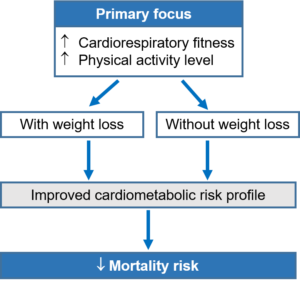The worldwide prevalence of overweight and obesity is a source of concern and we have no evidence that this situation will improve in the short term. Multiple weight loss programs have been developed and several of them include dietary and physical activity/exercise components. However, most approaches have generated mixed results over the long term as it is difficult to maintain a reduced body weight over years. Weight loss and weight regain cycles succeed one another and these episodes are sources of disappointment and frustration. Thus, are we going down the wrong path by aiming at weight loss as a primary target?
In this regard, an in-depth review paper published in iScience by Gaesser and Angadi addressed several issues around weight loss as a primary target of obesity treatment as opposed to alternative approaches aiming at managing obesity and associated cardiometabolic complications where weight loss is not the main therapeutic objective (Figure). Authors present evidence that: 1- the obesity-mortality relationship is largely mediated by the level of cardiorespiratory fitness and physical activity; 2- improvements in cardiometabolic risk markers are observed with an increase in the physical activity level; 3- weight loss is not always associated with a lower mortality risk; 4- a reduced mortality risk is associated with higher cardiorespiratory fitness or physical activity levels; and 5- several cardiometabolic complications increasing mortality risk are observed with weight cycling.

In light of the results presented in this comprehensive review paper, the authors suggest that it is time to revise our therapeutic targets and prioritize changes in lifestyle habits such as improving cardiorespiratory fitness and physical activity levels rather than aiming at weight loss (Figure). However, to achieve this goal, health professionals should learn about the tremendous clinical benefits of going from being sedentary to being physically active and fit. Furthermore, some living environments and conditions are not permissive for physically active lifestyles. On several occasions, we have proposed that societal solutions should be developed to reduce the prevalence of sedentary behaviors and physical inactivity in our population.